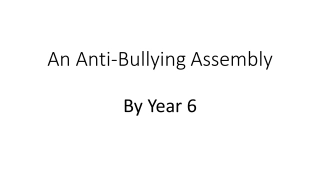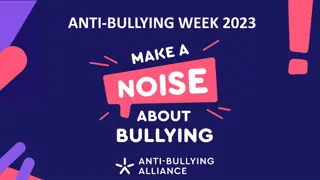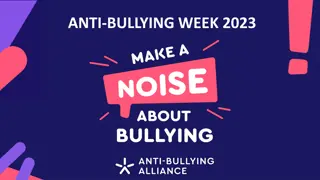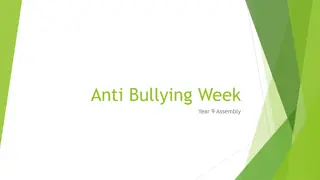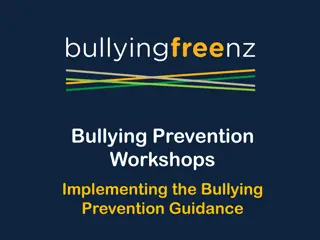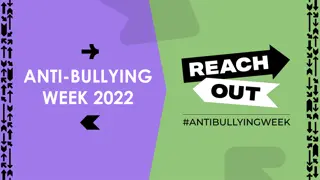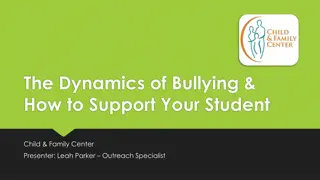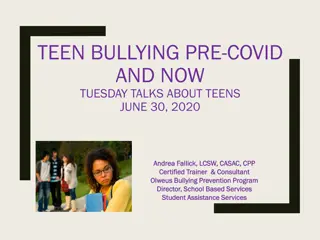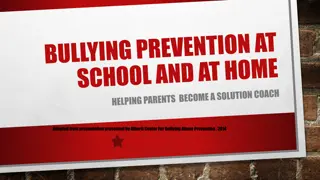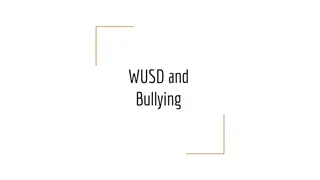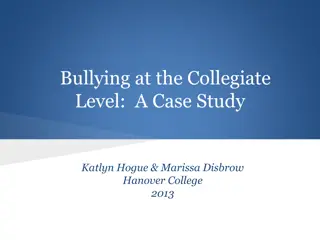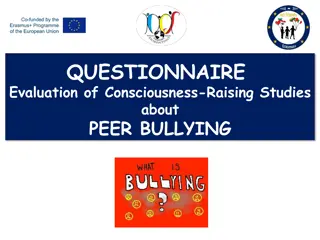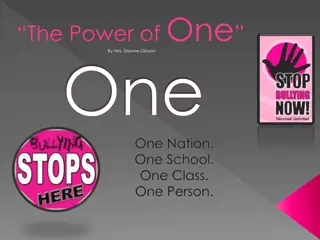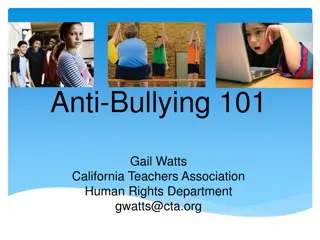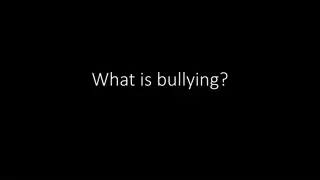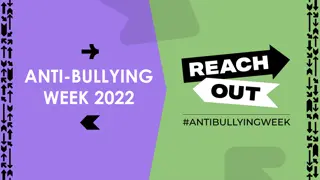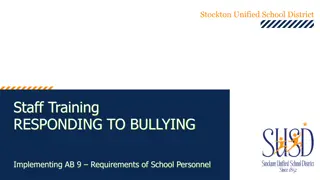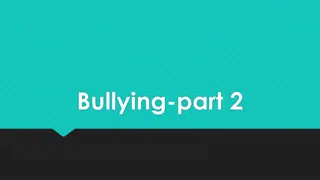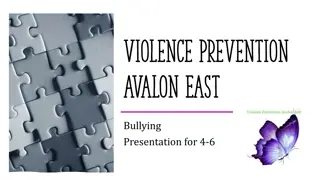Understanding Bullying of Students with Disabilities
Students with disabilities are at a higher risk of being bullied compared to their nondisabled peers, impacting their ability to learn. Bullying based on disability can be considered harassment, a civil rights issue. Federal and state laws protect these students, emphasizing the importance of bystander intervention, self-advocacy, and access to resources designed for their specific needs.
Download Presentation

Please find below an Image/Link to download the presentation.
The content on the website is provided AS IS for your information and personal use only. It may not be sold, licensed, or shared on other websites without obtaining consent from the author. Download presentation by click this link. If you encounter any issues during the download, it is possible that the publisher has removed the file from their server.
E N D
Presentation Transcript
Top Ten Facts Parents, Educators, and Students need to know: The Facts - Students with disabilities are much more likely to be bullied than their nondisabled peers 1. Bullying affects a student's ability to learn 2. The Definition - bullying based on a student's disability may be considered harassment 3. The Federal Laws - disability harassment is a civil rights issue 4. The State Laws - students with disabilities have legal rights when they are a target of bullying 5. The adult and peer responses are important 6. The Resources - students with disabilities have resources that are specifically designed for their situation 7. The Power of Bystanders - more than 50% of bullying situations stop when a peer intervenes 8. The importance of self-advocacy 9. Knowing you are not alone 10.
Get the Facts: Why it Matters 1. The Facts - Students with disabilities are much more likely to be bullied than their nondisabled peers Children with disabilities are 2-3 times more likely to be bullied than their nondisabled peers. One study shows that 60 percent of students with disabilities report being bullied regularly compared with 25 percent of all students. Many students with disabilities are already addressing challenges in the academic environment. When they are bullied, it can directly impact their education.
Get the Facts: Why it Matters 2. Bullying affects a student's ability to learn Bullying is not a harmless rite of childhood that everyone experiences. Research shows that bullying can negatively impact a child s access to education and lead to: School avoidance and higher rates of absenteeism Decrease in grades Inability to concentrate Loss of interest in academic achievement Increase in dropout rates
Get the Facts: Why it Matters 3. The Definition - bullying based on a student's disability may be considered harassment The Office for Civil Rights (OCR) and the Department of Justice (DOJ) have stated that bullying may also be considered harassment when it is based on a student s race, color, national origin, sex, disability, or religion. Harassing behaviors may include: Unwelcome conduct such as verbal abuse, name-calling, epithets, or slurs Graphic or written statements Threats Physical assault Other conduct that may be physically threatening, harmful, or humiliating
Get the Facts: Why it Matters 4. The Federal Laws - disability harassment is a civil rights issue 5. The State Laws - students with disabilities have legal rights when they are a target of bullying Most states have laws that address bullying. Some have information specific to students with disabilities. For a complete overview of state laws, visit Olweus.org.
Get the Facts: Why it Matters 6. The adult and peer responses are important Parents, educators, and other adults are the most important advocates that a student with disabilities can have. It is important that adults know the best way to talk with someone in a bullying situation. When preparing to talk to children about bullying, educators (parents and adults) should: Consider how they will handle the child s questions/emotions & what their own responses will be Be prepared to listen without judgment Provide the child with a safe place to work out their feelings & determine their next steps It is never the responsibility of the child to fix a bullying situation. If children could do that, they wouldn t be seeking the help of an adult in the first place.
Get the Facts: Why it Matters 7. The Resources- students with disabilities have resources that are specifically designed for their situation PACER Center: Champions for Children with Disabilities Walk a Mile in their Shoes Ability Path Autism Speaks: Autism Science
Get the Facts: Why it Matters 8. The Power of Bystanders - more than 50% of bullying situations stop when a peer intervenes Most students don t like to see bullying, but they may not know what to do when it happens. Peer advocacy students speaking out on behalf of others is a unique approach that empowers students to protect those targeted by bullying. Peer advocacy works for two reasons: First, students are more likely than adults to see what is happening with their peers and peer influence is powerful. Second, a student telling someone to stop bullying has much more impact than an adult giving the same advice. 1. 2.
Get the Facts: Why it Matters 9. The importance of self-advocacy Self-advocacy - the student with a disability is responsible for telling people what they want and need in a straightforward way. Students need to be involved in the steps taken to address a bullying situation. Self-advocacy is knowing how to: Speak up for yourself Describe your strengths, disability, needs, and wishes Take responsibility for yourself Learn about your rights Obtain help, or know who to ask, if you have a question The Student Action Plan is a self-advocacy resource to address the situation. Define the situation Think about how the situation could be different Write down the steps to take action 1. 2. 3.
Get the Facts: Why it Matters 10. Knowing you are not alone When students have been bullied, they often believe they are the only one this is happening to, and that no one else cares. In fact, they are not alone. There are individuals, communities, and organizations that do care. It is not up to one person to end the bullying and it is never the responsibility of the child to change what is happening to them. No one deserves to be bullied. All people should be treated with dignity and respect, no matter what. Everyone has a responsibility and a role to play as schools, parents, students, and the community work together for positive change.


